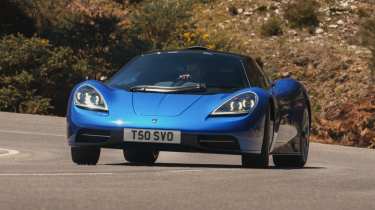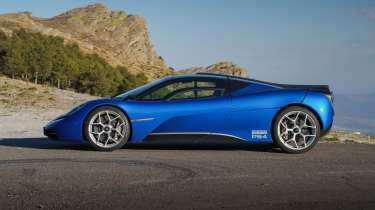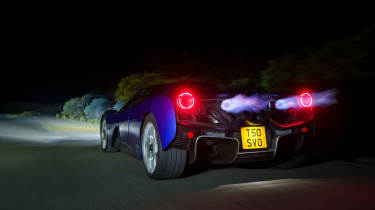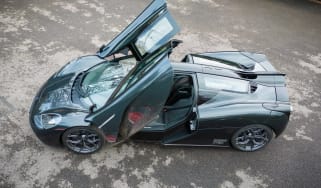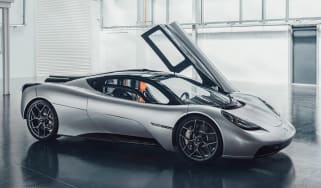Gordon Murray Automotive T.50 2025 review – the ultimate analogue hypercar
The GMA T.50 is the car we thought would never come: Gordon Murray's sequel to the ultimate hypercar, the McLaren F1
The Gordon Murray Automotive T.50 isn’t a car that’s defined by its numbers. At least not in the way that we’ve come to expect with modern hypercars like the Aston Martin Valkyrie, McLaren W1 and Ferrari F80. It isn’t defined by its power (661bhp) or performance figures (GMA doesn’t even quote any acceleration stats). However, there are some numbers that do provide a nice starting point for some of what the extraordinary T.50 is all about.
The first figure is the car’s weight – something that manufacturers often shy away from or obfuscate these days. It tips the scales at just 997kg dry – beating even its spiritual predecessor, the McLaren F1, by 21kg. This extraordinary lightness makes itself felt in so many of the T.50’s attributes. Like a child born into great wealth, this one characteristic sometimes subtly but always necessarily informs so much of its behaviour and sets it apart from so many of its peers.
The overall length (4352mm – 6mm shorter than a 987 Boxster) and width (1850mm – just 50m broader than a 987 Boxster) are also pertinent because this is a supercar that feels small and wieldy. It’s a sensation that is helped by the dirver’s central seating position, which not only gives you perfect vision to left and right but also places you a long way forward in the car, so that you feel very much on the tip of the arrow. Even with a passenger either side of you, the staggered pews mean the driver feels unencumbered.
Then there is the way its 4-litre V12 revs. Not only the soaring upper limit north of 12,000rpm but also the rapidity with which it gets there. Our second salient stat is that the engine speed builds at 50,000rpm per second. This is faintly terrifying when you first experience it with a tentative tread on the throttle. The response compared to most other cars is like trying to hit a James Anderson seamer after noodling around patting a beach ball with a paddle.
More reviews
That’s not to say the engine is unusable in normal driving conditions, because there is 265lb ft out of a total 353lb ft of torque from just 2500rpm, so it feels smooth and tractable low down with no histrionics. And while the clutch requires concentration, it isn’t unfriendly. But when you start to use the engine as it was intended, when you hear the screaming yowl approaching its zenith, you find that you’re in new territory.
Initially the intimidation is such that even when you think you must be using most of the revs, you find you’re short shifting at the point where a 911 GT3 runs out of puff, but the T.50 has over 3000rpm left to go. But there is some help at hand, because if you twirl the nicely weighted rotary switch on the transmission promontory to your right, you can delve into some menus and summon up rev-matching.
This might seem like a curious electronic aid to have in a car that has been touted as so pure and analogue, but it is actually a real boon. With an algorithm taking care of the blips on downshifts you can train your ear to the way the V12 behaves and you gradually get a feel for the car. There are also two throttle maps, with the initial GT mode giving a slightly softer response at the top of the pedal travel while Sport (which is only available once the engine is warm and the little orange light on the central rev-counter has been extinguished) gives a totally linear response.
Initially Sport feels like too much, but as you acclimatise to it and find new sensitivity in your right foot, you grow to love the reaction rather than fear it. And once you find you can control that V12, there is nothing quite like it. The intense, complex, screaming sound combined with the performance is utterly addictive and a succession of up-changes with the tight, precise manual, six-speed, Xtrac gearbox is something that will leave goosebumps on your arms for days afterwards. Possibly permanently. I’ve never – nor probably ever will – drive a 1990s Formula 1 car, but the sound and sensations delivered by the titanium valved, naturally aspirated Cosworth engine and the Inconel and titanium exhaust in the T.50 are good enough for me.
Even if the GMA T.50 handled like a rudderless dinghy in a swell, the engine would still be quite the transcendental experience, but thankfully, there is a chassis to match the drivetrain. There is a feeling of real depth to the suspension, with passive R53 dampers (mounted inboard at the rear) taking care of the ride quality. It’s not soft, but there is pitch and roll to play with. The nose in particular almost feels like it needs some brake pressure to help it bite when you’re going more quickly, but there is wonderful feel from the steering (unassisted above 10mph), so you can work with it.
Behind you, the relative lightness (178kg) and lowness of the engine mean that mid-engined momentum is usable rather than only manageable. The rear tyres are, by modern supercar standards, relatively modest with a section of just 295. They are also not too extreme in their compound or tread pattern, with Michelin Pilot Sport 4S rubber connecting you to the road rather than the Cup 2s you might expect.
As a result, you can use the rear to help you steer and at the mechanical, Salisbury limited-slip differential gives a fabulous feeling of connection once traction has been broken, the rear of the car almost floating over the tarmac like it’s riding on a fizzing, controllable cushion of air.
And talking of air, there is also the T.50’s aero to consider. The rear of the car is dominated visually by a 400mm fan that works with both the diffuser underneath the car and the rear flaps on top. Its modes are controlled by a switch on the dash and it can reduce drag (by 12.5 per cent), increase downforce (by 50 per cent) and help with braking.
The most noticeable of those attributes comes with the braking because when you hit the middle pedal at high speed and crush the pads into to the Brembo CCM-R discs you expect the car to dip quite significantly at the front but it doesn’t because the fan spins up and moves the centre of pressure rearwards. It’s almost spooky at first but there is no denying the strength of the stopping power.
Overall, the impact of the fan doesn’t feel as wild as the aesthetics of it might suggest and I think that’s a relief because there is nothing to cloud the more mechanical tactility of the driving experience. And it really is quite the experience. On the right piece of road or track with the freedom to link corners and use the revs, it is a car that immerses you totally in the processes and joys of driving.
As such, once you have experienced the incredible highs of a proper drive in a T.50, it’s very hard to pick holes in the car, because if you were to change anything and diminish the driving experience in the process, then it wouldn’t be worth it. However, if we’re being picky, then the screens instead of mirrors are a little hard to get used to, and although there is ample luggage space, the noise inside the T.50 at cruising speed would probably make you think twice about doing a really long journey in it.
The passenger seats aren’t the most spacious chairs to spend time in and clambering over to the centre seat isn’t the most elegant process. The start-up procedure is also a touch long-winded thanks to the 48v starter-generator unit (don’t stall it with a queue of traffic behind you) and the gearbox isn’t exactly slick and smooth when it’s cold. So, you have been warned, although if, as a potential buyer, you let any of those factors dissuade you from getting one, then this probably isn’t the car for you in the first place.
Price and Rivals
One very big number is the price of £2.8million, although all of the 100 cars are already sold (and it doesn’t seem to be a car that people are rushing to flip). That puts it on a par with cars like the Aston Martin Valkyrie that also has a naturally aspirated V12 from Cosworth but has its focus much more on track and aero performance.
The Ferrari F80, the Pagani Utopia and the upcoming Bugatti Tourbillon (with another naturally aspirated Cosworth engine) are all also rivals in terms of price and kudos. However, such is the character of the GMA T.50 that we would look more towards restomods like the Tuthill 911K or the Singer DLS in terms of cars striving for similar lightweight, naturally aspirated, analogue driving experiences.

